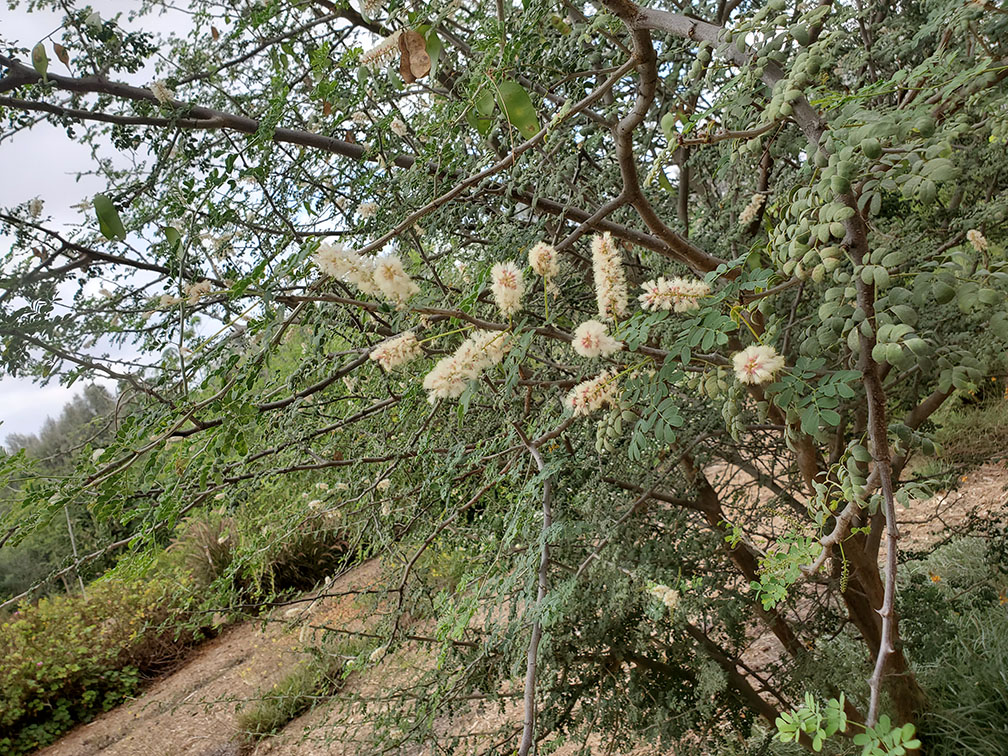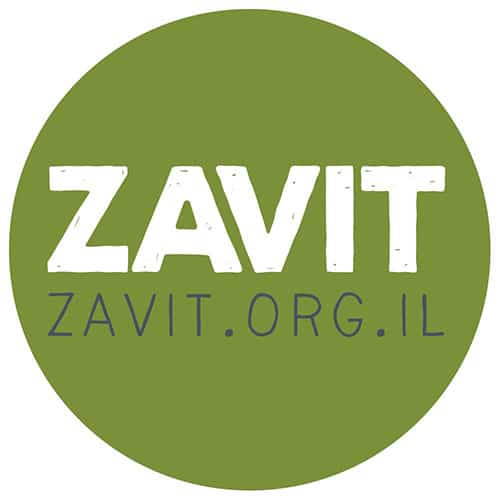 Gay Acacia. Photo by Tamar Kafri
Gay Acacia. Photo by Tamar Kafri Tamar Kafri was surveying the Gilat plant nursery of the JNF (Jewish National Fund, HaKeren HaKayemet LeYisrael) when she suddenly encountered a ghost from the past: a gay acacia tree. This unique species of acacia – with fragrant blossoms that seem as if someone replaced the grains on a stalk with small brushes, and with flat, wide pods as fruit – does not grow in the wild in Israel, and was last seen in nature next to the borders of the country in the 1960s. Yet, to Kafri’s surprise, the impressive tree was now before her eyes, alive and thriving.
Kafri, an agronomist with a master’s degree in ecology and a climate entrepreneur, was surveying the nursery for a study, the results of which were published in Forest (Ya’ar), a journal published by the JNF. The paper recommends that the ecosystem of the Negev and Aravah could be rehabilitated if it was planted with acacia trees from species not common nowadays in Israel.

According to Kafri, who conducted the survey as part of a JNF course training “foresters of the future”, acacias have an important role in the desert ecosystem. Still, the diversity of its species is in decline and their condition has taken a turn for the worse. Despite their high durability, the last 50 years have seen a shrinkage of over 60% of the number of acacia trees growing in the Aravah, due to tillage for agriculture, road building that diverts the streams flowing in the rainy season, and long periods of drought.
As a result, many species that live next to the trees are harmed: among the animals that have a close connection to the acacias, you can also find rare species, such as the Aravah gazelle, the desert hedgehog, and the Pharaoh eagle-owl. “Not many perennial plants grow in the desert, and the acacia provides shelter from the heat and nectar and produces a lot of nitrogen necessary for other plants growing next to it,” says Kafri. “The tree serves as an oasis for more than 50 species of plants and wildlife.”
What We Learned from the Pines
Despite its significance, there are only 4 species of acacia that are common in the Negev and Aravah, and a greater variety of species is desired, in a way that will help the ecosystem. “We want to avoid a situation where ecosystems are too homogeneous – so that if any one species of the tree is attacked by a harmful species, the entire ecosystem doesn’t go down with it,” explains Kafri.
An example of the importance of diversity in trees is the case of the Israel pine bast scale, an invasive species of insects, that apparently arrived in Israel with imported Turkish pines. In the 1970s, this species attacked vast areas of forest, and many trees of the Jerusalem pine species were damaged. This outbreak was one of the reasons the JNF changed its mode of operation and started planting forests with multiple species of trees, instead of homogeneous pine forests.
It is worth mentioning that a similar invasion of a harmful species would have a much more devastating effect if it were to occur in the Negev and Aravah areas, as plants grow there much more slowly, and not many species can survive the harsh conditions of these areas.
An Acacia for Each Purpose
The Gilat plant nursery, which has been growing about 30 species of acacia in the past two decades, is now ready to enter the scene: “the purpose of the survey was to collect information from the nursery about characteristics of the different species, and to form a detailed list of acacia species that can be relied upon for planting and recovery,” says Kafri.
Most of the species in the survey are not native to Israel, but they do come from areas that have climate systems similar to that of the Negev and Aravah areas – African deserts with one rainy season and one dry season. “Acacias are key species in the desert ecosystem,” says Kafri. “Even a tree not native to that ecosystem can serve as an oasis for many species, a fact that can be observed in nature.”
Kafri and her team, Denis Lozkovoy and Gilad Reisfeld, who also took part in the “foresters of the future” course, focused on 12 species of acacia growing in the Gilat nursery, whose survival rate during the last two decades was over 88%. They examined two main criteria: the diameter of the trunk and a measure of the clumpiness of the canopy, which ultimately quantifies the shade given by the tree.
Following the survey, the researchers created a list of different species of acacia, together with the use they can have when used in afforestation. “Trees whose canopy is more clumped together, such as the umbrella thorn acacia, are suitable for resorts,” says Kafri. “They can be planted in the public campsites in the Aravah for people to enjoy the shade when they take a refreshment break there.” According to her, species that have higher trunks – with height measuring over 6 meters – such as the red acacia, are best planted away from roads and human settlements so that they won’t be disturbed by us, and a variety of animals and plants may thrive. According to the paper, a noticeable presence of tall trees allows for shorter trees to grow under them, so that a multi-layered and diverse ecosystem can be formed.
It is important to note that the introduction of new species into an ecosystem is no small matter: actions must be taken slowly and deliberately, to examine the influence of the foreign species on their new environment and to make sure that they cause no harm; that they don’t become an invasive species. That is the case even with species that have previously grown there or close nearby, especially since environments tend to change over time (and even more so in a time of a climate crisis such as ours).
From the Past, For the Future?
One of the recommendations by the researchers is to plant the gay acacia in Israel – even outside of the nursery where Kafri incidentally encountered it. An instance of the gay acacia was first recorded in 1891, south of the dead sea (at a place now governed by Jordan) – but it doesn’t grow in Israel in the wild. “This year saw the passing of Shuka Ravek, an amazing person and one of the most prominent hikers and amateur botanists in Israel,” tells Kafri. “After the peace treaty with Jordan, when the borders opened up for tourists, he went on a tour there with botanist Prof. Avi Shmida, where they found the gay acacia.” According to Kafri, seeds of the tree were later imported to Israel, and the tree was planted in botanical gardens around Israel. “I believe that the Jerusalem botanical garden at that time already started considering growing trees of the species in Israel.”
Kafri believes that the trees she saw in the Gilat nursery were 6–7 years old. “They were adult trees rising to a height of over 2 meters,” she says. “I started asking questions, and I learned that there are a few trees of the species in Israel. Its blossoms are impressive – and its seeds grow in quantities that allowed for passing seeds and shoots among the botanical gardens in Israel.”
Kafri claims that the fact that the gay acacia managed to take root in several locations is a reassuring sign of the chances of its survival in nature – so as of the possibility to plant it in places with very rough conditions. “The recording of the gay acacia in the 19th century was near Sodom – an area with hard soil, with very scarce nutrients, where not many plants can survive,” she explains.
“If processes such as the ones we recommend are taken into action, it would be an excellent opportunity to reintroduce species which have long disappeared from the local scene – an effect which has a merit of its own,” concludes Kafri.
This article was prepared by ZAVIT – The News Agency of the Israeli Society of Ecology and Environmental Sciences






















 More news and opinions than at a Shabbat dinner, right in your inbox.
More news and opinions than at a Shabbat dinner, right in your inbox.